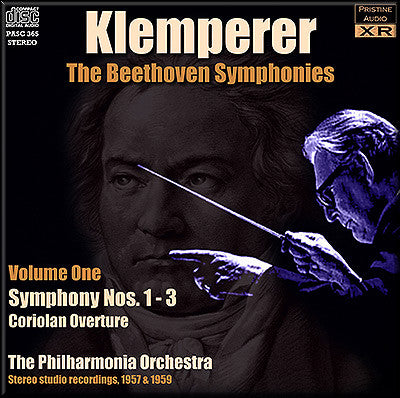
- Producer's Note
- Full Track Listing
- Cover Art
- Additional Notes
Klemperer's classic Beethoven Symphony Cycle starts here
Unprecedented sound quality in these new 32-bit XR-remastered transfers
Klemperer was a busy man in 1957 and thereabouts. Having polished off the Brahms symphonies (Pristine Audio PASC360-362) in the springtime, he soon set to work on the Beethoven canon. October alone saw recordings in London's Kingsway Hall of the bulk of the series - all or part of the First, Second, Fourth, Sixth, Eighth and Ninth were taped in stereo during this month, together with the Coriolan Overture present in this volume.
It's true to say that the recordings were very well made for their day - better perhaps than the Brahms which had preceded them. XR remastering here isn't a question of rescuing a dismal historic artefact; rather it's a case of eliciting the very finest sound quality possible from from fine source material - digging deep into the bass for added richness; opening out oft-constricted strings; lifting a veil from the upper treble. In short, whilst the current EMI transfers are perfectly acceptable representations of what was possible in 1957, these
- BEETHOVEN Symphony No. 1 in C, Op. 21
- BEETHOVEN Symphony No. 2 in D, Op. 36
- BEETHOVEN Symphony No. 3 in E flat, Op. 55 "Eroica"
-
BEETHOVEN Coriolan Overture
The Philharmonia Orchestra
Otto Klemperer conductor
Recording dates:
Symphony No. 1 recorded 28-29 October 1957
Symphony No. 2 recorded 4-5 October 1957
*Symphony No. 3 recorded 29 October & 11-13 November 1959
Coriolan Overture recorded 21 October 1957
Recorded at Kingsway Hall, London
*Studio One, Abbey Road, London
XR remastering by
Cover artwork based on a photograph of Otto Klemperer
Total duration: 2hr 9:10
KLEMPERER AND BEETHOVEN
All of us owe a debt to Walter Legge - even the music critics among us - for his acumen in detecting great gifts and his ruthless determination that they shall be displayed in this country. It is principally due to him that Klemperer's stature was at last established here; London has a firm tradition of Klemperer neglect going back to the early thirties, when only a few critics shouted his greatness into deaf ears. In recent years there have been few more profoundly thrilling events than those tremendous Beethoven series, few more exciting moments than when the curtain to the artists' room of the Festival Hall was suddenly pulled aside and that great figure came shuffling out, stick held aggressively forward, hand groping for the rail, the huge head flung back like an Easter Island statue. If one raised one's eyes to a box above, there usually was Mr. Legge concealed behind a triumphant grin, and if one had recovered from the concert sufficiently by morning, one could limp round to the shops for the records of the Beethoven symphonies which Mr. Legge's Columbia connection provided...
John Warrack, The Gramophone, August 1960
Fanfare Review
If you are new to Klemperer in Beethoven, get this set, especially for the outstanding “Eroica.”
After reviewing
The performances are legendary. The First, from
1957, is spacious and noble. Although recorded just three weeks earlier,
the Second has slightly muddier sound. Klemperer’s interpretation is
fiery, with splendid architecture. An interesting contrast is from the
live 1958 performance of this work, in very good monaural sound, with
the Berlin Radio Symphony in Klemperer’s “Great Conductors of the 20th
Century” set. It is not as well played as the studio version, but it is
quicker and crackles with nervous energy. As for Klemperer’s 1959
“Eroica,” it features the best sound of all Rose’s remasterings. It is a
shattering human document, slower and less quicksilver than the
splendid version Klemperer recorded in monaural only four years earlier.
Concerning the Coriolan Overture,
it could not be bettered. If you are interested in comparable
performances to Klemperer’s but with better sound, I would recommend
George Szell and the Cleveland Orchestra in the first two symphonies,
and in the “Eroica,” Hiroshi Wakasugi and the Saarbrücken Radio
Symphony. In addition to the “Eroica,” Wakasugi recorded sterling
accounts of Bruckner’s Second and Ninth with this orchestra.
Dave Saemann
This article originally appeared in Issue 36:5 (May/June 2013) of Fanfare Magazine.

